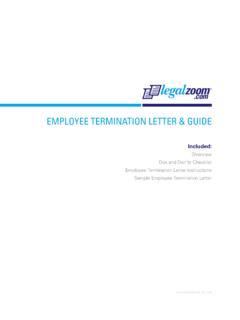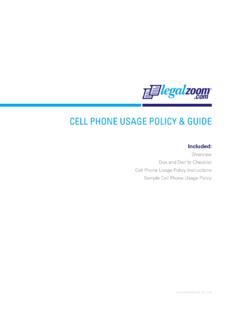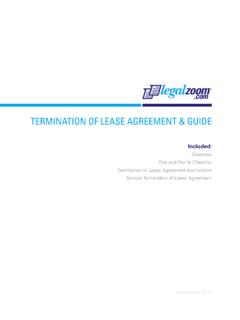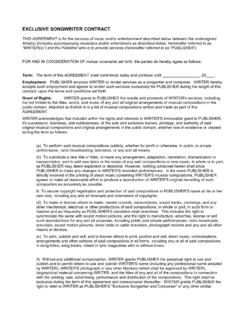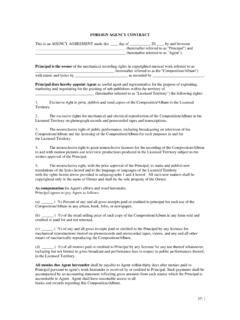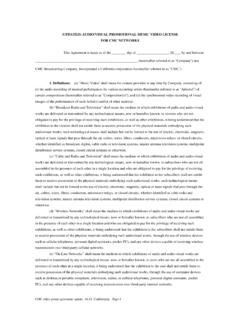Transcription of COPYRIGHT LICENSE AGREEMENT (ARTWORK) & GUIDE
1 COPYRIGHT LICENSE AGREEMENT ( artwork ) & GUIDEI ncluded:Overview Dos and Don ts Checklist COPYRIGHT LICENSE AGREEMENT ( artwork ) Instructions Sample COPYRIGHT LICENSE AGREEMENT ( artwork ) , INC. 2008 1 COPYRIGHT LICENSE AGREEMENT ( artwork ) , INC. 2008 1. Overview An organization s ability to buy and sell property is essential to its long-term life and vitality. Although it does not take up physical space, an excess of intellectual property can burden a company, directing limited funds towards maintaining registrations, defending against third-party claims, or creating and marketing final products. Licensing intellectual property can have an immediate positive effect on a company s finances, generating revenue and decreasing costs. A company looking to obtain a LICENSE in property (including artwork ) must be sure that the licensor does, in fact, have title to the desired items.
2 A properly-drafted COPYRIGHT LICENSE AGREEMENT can help in both circumstances. A non- exclusive COPYRIGHT LICENSE AGREEMENT allows the licensee to use (but not own) the owner s creative works. Licensing can help a company obtain rights needed to sell or manufacture its own products effectively and easily, while lending the licensee an established image. The marketing efforts made by the licensee will in turn benefit the licensor s art and reputation. Use the enclosed document to LICENSE copyrighted artwork for use by another party. You can provide detailed information about how the art will be used and the extent of its incorporation into a publication or other work. The COPYRIGHT holder will know that its rights are protected, and the licensee will be well on its way to getting rights to the artwork it needs to complete its work. 2. Dos & Don ts Checklist A COPYRIGHT is a form of protection provided by federal law to creators of original works of authorship.
3 This includes both published and unpublished literary, dramatic, musical, and artistic works. A COPYRIGHT protects any form of an idea s expression, and therefore extends to items like maps, charts, artwork , cartoons, and screen displays. The author or creator of a copyrighted work can prevent others from copying or using the work without his or her consent. A third party intending to reproduce all or any part of a copyrighted work must first obtain the permission of the COPYRIGHT holder. Failure to do so could result in a lawsuit and substantial fines. Note that in COPYRIGHT law, an exclusive LICENSE essentially works as a transfer of ownership rights. The exclusive licensee has the right to use the COPYRIGHT , assign it to a third party, or sue a third party for infringement. A non- exclusive licensee also has the right to use the COPYRIGHT , but neither of the other two rights.
4 Not every use of another person s copyrighted material will be considered a COPYRIGHT violation. American COPYRIGHT law contains a concept called fair use, which allows third parties to use copyrighted works without permission if those works are used for purposes of criticism, comment, news reporting, teaching, scholarship, or research. There are other factors involved in assessing whether unauthorized use is fair use (including the purpose of the use, the nature of the copyrighted work, the amount used, and the effect of the use on the market or value of the copyrighted work), and it s not always an easy or clear determination. The best practice is to obtain permission from a COPYRIGHT holder in every context, rather than risk the damages and costs that could result from a LICENSE AGREEMENT ( artwork ) , INC. 2008 Another type of material that does not require permission to republish is work existing in the public domain.
5 A work in the public domain is not simply a work that is publicly available; it is a work that is either not currently or never was protected by COPYRIGHT . Public domain works generally fall into one of the following categories: General information ( , facts or numbers). Materials created by the government. Items that had copyrights that expired because of time or because the holder didn t renew the COPYRIGHT . For example, vintage art produced before 1923 is usually in the public domain. Materials created before 1989 that lacked proper COPYRIGHT notices. Getting commercial rights for artwork is often a two-step process. In the first step, the requestor must locate the COPYRIGHT holder of the art, which is usually the artist or his or her heirs. This is true regardless of who owns the work itself. That is, although an art collector may own a painting, he or she may not own the right to distribute the painting s image.
6 In the second step, if the requestor needs to use a photograph or other reproduction of the work in order to reproduce it, it will need to obtain the permission of the owner of the photograph or reproduction. This secondary work has its own COPYRIGHT and separate permission will therefore be needed. Determining who holds the COPYRIGHT in a given work can be complicated, but there are certain basic steps that can help in most situations. If you are using artwork initially published in a book, the COPYRIGHT holder may be listed on the page after the title page. If you are using artwork initially published in a journal or periodical, contact the publisher of the work (which usually owns the COPYRIGHT in all of that work s contents). Information on the publisher of a journal or periodical can usually be found in the masthead. If you cannot find information on the COPYRIGHT holder of the artwork you wish to reproduce, contact the COPYRIGHT Office or review the archives available on its website ( ).
7 A COPYRIGHT LICENSE is typically accomplished through a contract, like the written AGREEMENT form that follows. Although not technically required, licenses can also be recorded with the COPYRIGHT Office (USCO) to provide notice of the document s existence. The advantage of this recording is that it provides a public record of the LICENSE , and may establish priority rights if there is a dispute about whether or not a transfer is valid. No special forms are needed for recordation, although the USCO does encourage registrants to use a Document Cover Sheet to facilitate such recordings. If you decide to file a Document Cover Sheet, provide at least two (2) copies of this form with the LICENSE itself. There will be a fee for this recording (currently $95 for each title). A COPYRIGHT LICENSE does not have to be forever and does not need to be a complete or exclusive LICENSE .
8 You can grant a transfer for a specific period of time, in a specific area, or for a specific medium ( , allow online use but not film use). Both parties should review the completed AGREEMENT carefully to ensure that all relevant deal points have been included. It is better to be over-inclusive than under-inclusive. Do not assume that certain expectations or terms are agreed to if they are not stated expressly in the LICENSE AGREEMENT ( artwork ) , INC. 2008 Sign at least two copies of the AGREEMENT , one for you and one for the other party. It s a good idea to have the AGREEMENT notarized or witnessed. This will limit later challenges to the validity of a party s signature. If your AGREEMENT is complicated, or if you don t understand its uses or requirements, do not use the enclosed form. Contact an attorney to help you draft a document that will meet your specific needs.
9 3. COPYRIGHT LICENSE AGREEMENT ( artwork ) InstructionsThe following provision-by-provision instructions will help you understand the terms of your numbers and letters below ( , Section 1, Section 2(a), etc.) correspond to the provisions in the contract. Please review the entire document before starting your step-by-step process. Introduction of Parties. Identifies the document as a COPYRIGHT LICENSE AGREEMENT . Write in the date on which the AGREEMENT is signed. Identify the parties and, if applicable, what type of organization(s) they are. Note that each party is given a name ( , Licensor ) that will be used throughout the AGREEMENT . As you probably guessed, the Licensor is the party that owns the COPYRIGHT and is giving permission (or LICENSE ) to use the underlying artwork and the Licensee is the party that asked for permission to use that work. Recitals.
10 The whereas clauses, referred to as recitals, define the world of the AGREEMENT and offer key background information about the Parties. In this document, the recitals include a simple statement of the intent to LICENSE rights in the artwork . In the space provided, give specific details about the artwork that will be reproduced. Include the name of the artist, the title of the piece, and the date on which it was created or published. If published, the creation date may be found in the first few pages of the work in which it first appeared. If applicable, try to provide additional information about the medium in which the work was created ( , oil painting, lithograph, etc.) and its approximate dimensions. If there is an ID number available (either through a museum or other organization), feel free to include that as well. It may be a good idea to enclose a reproduced copy of the artwork ; if you do so, keep the bracketed clause and attach a copy to the AGREEMENT as Exhibit A.


